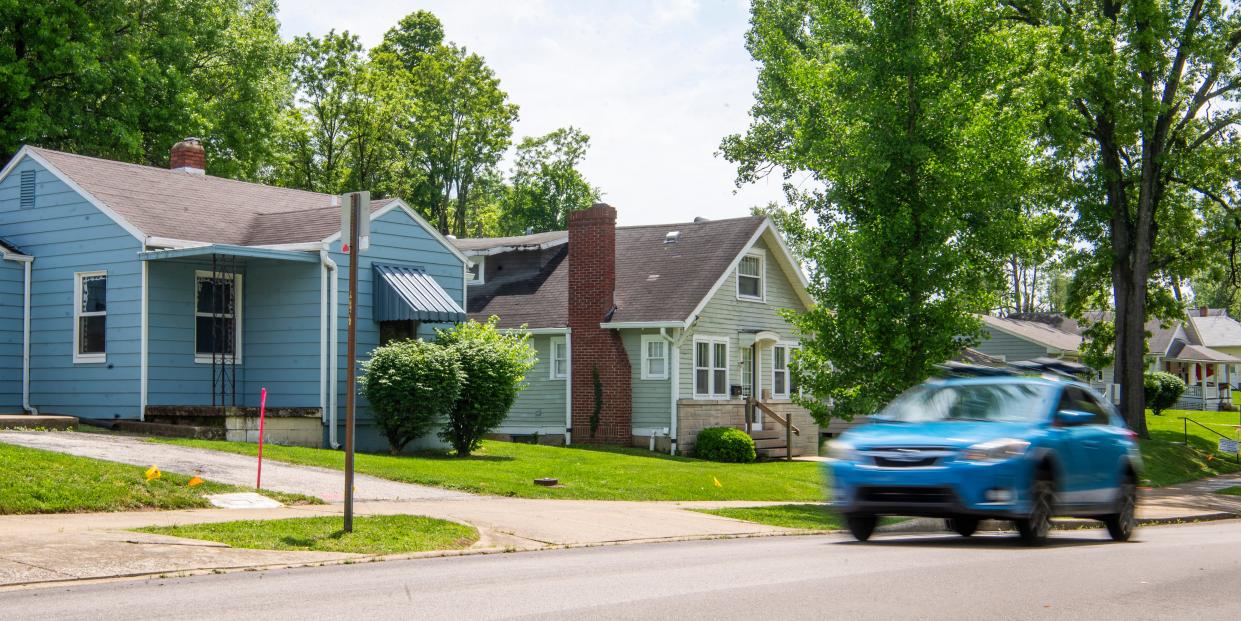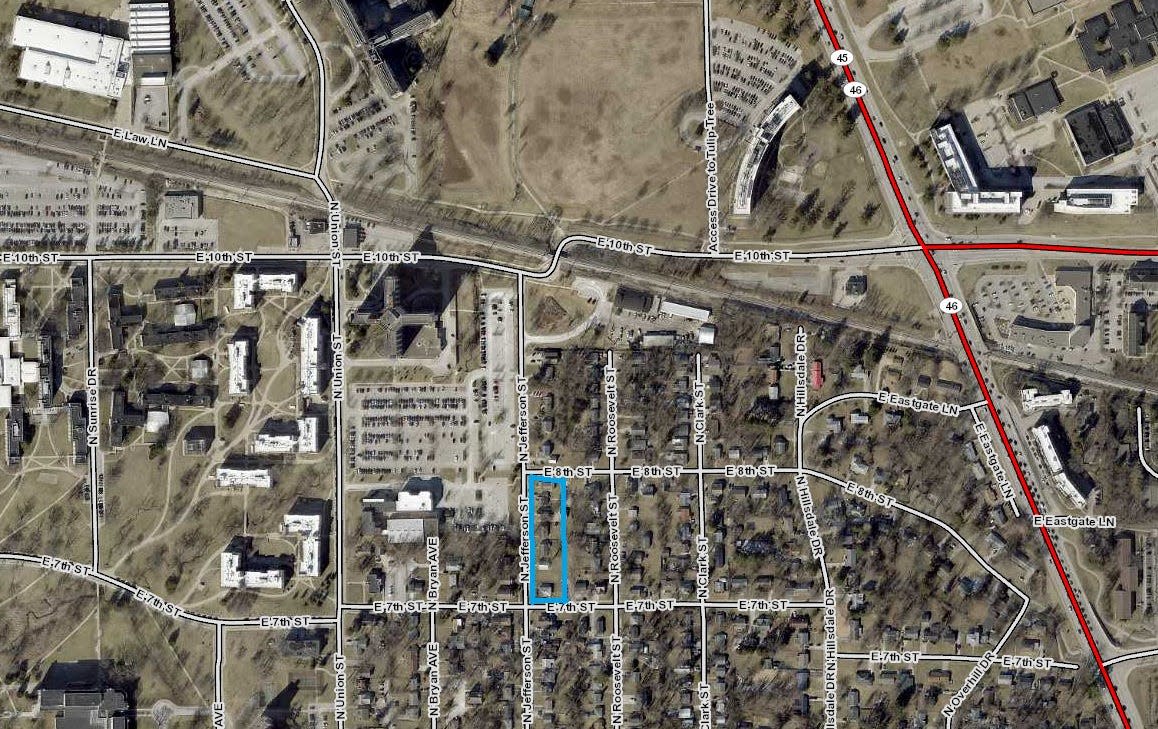Historic homes in Bloomington up for demolition; student housing planned

Five historic homes on the city’s east side, with ties to Indiana University, sculptures and Crest toothpaste, may face demolition to make way for student housing.
The Bloomington Historic Preservation Commission is expected to make a ruling on the demolition request on Thursday.
The real estate agent who has requested the demolitions said a potential buyer of the properties wants to make sure they can replace the existing houses with low-density student housing before completing the purchase.
The five homes sit along the west side of North Jefferson Street, east of the IU campus and southeast of Eigenmann Hall. Some of the homes date to the World War II era and have ties to the university.

The homes include:
A bungalow at 324 N. Jefferson St., built in the 1940s. According to a report by the Bloomington Housing and Neighborhood Development Department, occupants of the home included influential sociologist George Psathas, child psychologists Louise and Dale Gilsdorf, gender studies researcher Don Auster and business professor Nancy Auster, student and peace activist Joe Grabill and Japanese philosopher Kan Ori. IU sculpture professor Jean-Paul Darriau bought the home in 1978. His works include the "Red, Blonde, Black, and Olive" statues at Miller-Showers Park and the bronze "Adam and Eve" statues in Dunn Woods.
A ranch home on 318 N. Jefferson, built around 1950 and inhabited in the late 1950s by IU French professor Edward Najam, who served on the Rhodes Scholarship and Woodrow Wilson Fellowship selection committees and served as assistant dean in the College of Arts and Sciences from 1958 to 1963. “For his work promoting French language education, he was inducted into L’Ordre des Palmes Academiques by the Republic of France,” according to HAND.
A ranch home at 314 N. Jefferson, a mirror image of the neighboring property at 318 N. Jefferson. According to HAND, the home was built in the early 1950s and “represents a common form of National Home designed for veterans seeking to enter the housing market.” Occupants included U.S. Army Cpl. Russell Gross and his wife, Anna, who obtained a doctorate in education from IU before teaching at Unionville Elementary. “Born Anna Lee Deckard on Deckard Ridge Rd in what is now Yellowwood State Forest, and attended the Deckard school, entirely staffed by Deckards. Anna taught in one-room schoolhouses in Brown County and at Camp Atterbury during WWII before coming to IU, Anna completed her BA in 1953 at the age of 39,” HAND wrote.
A bungalow at 310 N. Jefferson St., built in 1945. The home was occupied in the 1950s by Donald Baugh, a driver for the university. The house became a rental in the 1960s.
A ranch at 2201 E. 7th St., at the corner of North Jefferson and East Seventh streets. The home was built in 1940 and occupied in the 1950s by IU chemistry professor Robert Fischer. During WW II, Fischer was stationed in Oak Ridge, Kentucky, where he researched heavy water for the Manhattan Project. While at IU, Fischer studied the efficacy of fluoride in toothpaste and, according to HAND, “was given the patent for Crest toothpaste, which helped fund the Oral Health Research Institute at IUPUI in 1968.”
The city considers the homes to be “contributing,” the second-lowest among the four classifications: outstanding, notable, contributing and non-contributing.
Noah Sandweiss, historic preservation manager for HAND, said the classification “contributing” indicates the structures were identified as potentially eligible for historic protection, but they are not so designated at this point, neither locally nor nationally.
Criteria by which the commission determines historical significance include the architecture, the structure’s connection to significant historic periods and the homes’ relationships to people who have made a significant contribution to local, state or national history, he said.
City staff are recommending that all demolition requests be approved, though the commission will have the final say. City officials said staff are not opposed to demolition in part because the city still has other, similar neighborhoods that represent that period of development.
According to local property records, the whole east side of Jefferson Street between Seventh and Eighth streets is owned by Bloomington-based Doorman Enterprises LLC, which acquired the properties in 2019 for $1.65 million. According to documents filed the the Indiana Secretary of State's office, the company’s president is Douglas Johnson, who also owns Comfort Keepers, an in-home care business, at 4334 E. Third St.
Sable Beyers, of Bloomington-based Beyers Realty, said a prospective buyer of the properties wants to make sure the homes can be demolished before the purchase is finalized. She said the potential buyer hopes to build “low-density student housing,” though she said she could not share details at this point.
Zoning on the properties would allow anything from single-family homes to multiplexes and an apartment building that crosses multiple lot lines, said Gabriel Holbrow, a planner with the Bloomington Planning and Transportation Department. The maximum height of an apartment building is 5.5 stories, so long as the developer meets affordable housing and sustainable development incentives. The sixth floor would be stepped back from the fifth and could have an area of no more than half of the fifth floor.
The HPC will meet at 5 p.m. Thursday at the McCloskey Room in City Hall at 401 N. Morton St. You can follow the proceedings via Zoom at tinyurl.com/mrurr3zy.
Boris Ladwig can be reached at bladwig@heraldt.com.
This article originally appeared on The Herald-Times: Historic homes in southern Indiana with IU ties up for demolition
